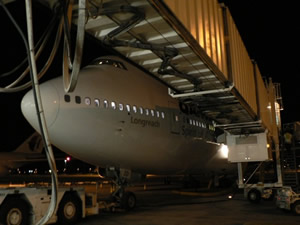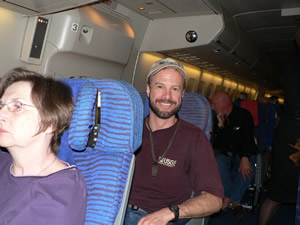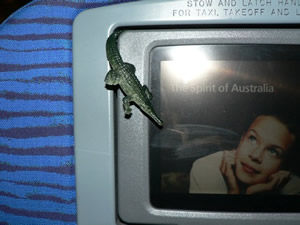Home|Glossary|Links|Journal|Maps
Destination McMurdo Station
|
The day started out decidedly chilly for all of us – somewhere in the 30° F temperature range. But by the time Kirk Miller, Ray Woodruff, and I met up at the Los Angeles International Airport, the weather had transformed - to what unintentionally long-time L.A. resident Doug Pace describes as the typical “sunny, dry, 70° F, with a slight chance of an earthquake.” Weather describes day-to-day variations in the conditions of the earth’s atmosphere. It is influenced by oceans and mountain ranges and affected by the time of day, time of year, and by latitude. Over the next days the weather Kirk, Ray, and I would experience was going to continue changing greatly. The three of us had met up at the airport because we were all heading to the same place...Antarctica.
|

Ray and Kirk in the Los Angeles Airport
|
Kirk and Ray are hydrologists with the United States Geological Survey – Wyoming Water Science Center, and I am a PhD student in water resources engineering at the University of Colorado-Boulder. We’re going down “to the ice” as part of the Stream Team that studies glacial meltwater streams in Antarctica’s largest ice-free zone, an area known as the McMurdo Dry Valleys. |
 Our L.A. to Aukland, New Zealand plane - photo by Kirk Miller
Our L.A. to Aukland, New Zealand plane - photo by Kirk Miller |
This initial leg of our journey involved a one shot 6500 mile flight from Los Angeles to Auckland, New Zealand. While we were excited to see New Zealand and to be en route to the southernmost continent, we weren’t exactly looking forward to the flight itself. It involved something that none of us was very fond of – an extended period of sitting. During the 12-hour flight as we sat, we read, listened to music, watched movies, and tried in vain to find a comfortable position in which to sleep. We also changed time zones, latitudes, hemispheres, and seasons – victims of our aircraft’s 550 miles per hour progression south and of the earth’s orbit and relentless rotation. The earth spins counterclockwise like a basketball on a finger. One complete rotation takes 24 hours, and it is the change in the side of the earth facing the sun that creates day and night. The finger on the basketball is part of the axis of rotation and the point where the finger touches the ball is equivalent to a geographic pole. Different points on the earth experience the sequence of day and night differently resulting in the need for various time zones. |
| About an hour and a half into the flight we were munching on a dinner of curried chicken or pasta primavera in the Honolulu time zone. Several more hours passed. Ray had watched the movie Wedding Crashers, Kirk had listened to the entire Jazz with James inflight radio program. I had fallen into a fitful sleep. And we had crossed a latitude of 23.5° north, the Tropic of Cancer. A few more hours into the flight, Ray had started in on his new book, The Home of the Blizzard, by Australian Antarctic explorer Douglas Mawson. Kirk had fallen asleep and missed the snack pack of cheese, crackers, and chocolate. I had saved an urban metropolis from certain destruction by stopping deadly lava flows some 30 times over – in a video game played on the personal television monitor in back of the seat in front of me. And we had crossed the equator, the imaginary line that divides the earth into two equal parts, the northern and southern hemispheres and that with a value of zero is the starting point for degrees of latitude.
|
| Yet more hours later, Ray was still awake and watching the movie the World’s Fastest Indian about a New Zealander who raced Indian motorcycles. Kirk woke up with a splitting dehydration headache. I was working on a Sudoku puzzle that one of my best friends, Amy, had introduced me to. And we had traversed the Tropic of Capricorn at 23.5° south and crossed the International Date Line, which is another imaginary line that for the most part follows the 180° line of longitude and that separates two consecutive calendar days.
|
 Kirk is jazzed about the flight - photo by Ray Woodruff
Kirk is jazzed about the flight - photo by Ray Woodruff |  Liz, Kirk's iguana, is watching the television monitor in the back of the plane seat
Liz, Kirk's iguana, is watching the television monitor in the back of the plane seat |
|
|
|
Next>>
|

